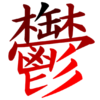Translingual[edit]
| Stroke order
|

|
| Stroke order
|

|
Han character[edit]
鬱 (Kangxi radical 192, 鬯+19, 29 strokes, cangjie input 木木月山竹 (DDBUH), four-corner 44722, composition ⿳⿲木缶木冖⿰鬯彡)
Derived characters[edit]
References[edit]
- Kangxi Dictionary: page 1458, character 18
- Dai Kanwa Jiten: character 45671
- Dae Jaweon: page 1990, character 22
- Hanyu Da Zidian (first edition): volume 2, page 858, character 12
- Unihan data for U+9B31
Chinese[edit]
Glyph origin[edit]
|
|
Old Chinese
|
| 鬱
|
*qud
|
| 欝
|
*qud
|
| 灪
|
*qud
|
| 爩
|
*qud
|
Originally ideogrammic compound (會意/会意) : 林 (“forest”) + 大 (“person”) + 勹.
Now phono-semantic compound (形聲/形声, OC *qud) : semantic 林 (“forest”) + phonetic 𩰪 ().
Pronunciation[edit]
| Baxter–Sagart system 1.1 (2014)
|
| Character
|
鬱
|
| Reading #
|
1/1
|
Modern
Beijing
(Pinyin)
|
yù
|
Middle
Chinese
|
‹ ʔjut ›
|
Old
Chinese
|
/*qut/
|
| English
|
blocked; anxious
|
Notes for Old Chinese notations in the Baxter–Sagart system:
* Parentheses "()" indicate uncertain presence;
* Square brackets "[]" indicate uncertain identity, e.g. *[t] as coda may in fact be *-t or *-p;
* Angle brackets "<>" indicate infix;
* Hyphen "-" indicates morpheme boundary;
* Period "." indicates syllable boundary.
|
| Zhengzhang system (2003)
|
| Character
|
鬱
|
| Reading #
|
1/1
|
| No.
|
16057
|
Phonetic
component
|
鬱
|
Rime
group
|
物
|
Rime
subdivision
|
2
|
Corresponding
MC rime
|
鬱
|
Old
Chinese
|
/*qud/
|
Definitions[edit]
鬱
- lush; luxuriant; exuberant; dense; thick
- various; abundant; profuse
- deep; obscure; profound
- to gather; to stagnate; to become stagnant
- depressed; gloomy; moody
- melancholy; depression
- to begrudge; to resent; to feel aggrieved
- hot air (rising); steam
- a kind of plum
- name of a god
- tall and big
- putrid; putrefied
- tulip; fragrant grass
- alt. forms: 𩰪 (yù), 䖇 (yù)
- (~水) name for a branch of the Pearl River, including the You River, Yu River and the Xun River in Guangxi, as well as the Xi River downstream in Guangdong
- (~郡) name of an ancient Chinese prefecture
- a surname
Compounds[edit]
Japanese[edit]
鬱
(common “Jōyō” kanji, kyūjitai kanji, shinjitai form 欝)
- depression, gloom, melancholy
Readings[edit]
Compounds[edit]
鬱 has, at 29 strokes, the most strokes of any kanji in the jōyō kanji list or kanji kentei level 2.[1] The next highest kanji in the jōyō list is 鑑, at 23 strokes.
Prior to the Japanese script reform, this character was handwritten as 欝 using 25 strokes, similar to how "令" is often written differently in handwriting. However, after the reform, the character was excluded from the official lists. In 2010, only the print form was included in the new jōyō kanji list, and it is today taught to be written like the print form instead of like 欝 .
Etymology[edit]
From Middle Chinese 鬱 (MC 'jut).
Pronunciation[edit]
Adjective[edit]
鬱 • (utsu) -na (adnominal 鬱な (utsu na), adverbial 鬱に (utsu ni))
- depressing
- 鬱な曲
- utsu na kyoku
- depressing song
- depressed
- 鬱な気分
- utsu na kibun
- gloomy mood
- 鬱になりそう
- utsu ni narisō
- to be almost depressed about something
鬱 • (utsu)
- (psychiatry) depression
- 鬱を克服する
- utsu o kokufuku suru
- overcome depression
Synonyms[edit]
鬱 • (utsu)
- dense (growth); lush; luxuriant
- accumulate; stagnate
- depression; gloom; melancholy
References[edit]
Alternative forms[edit]
Etymology[edit]
From Middle Chinese 鬱 (MC 'jut).
Pronunciation[edit]
Wikisource
鬱 (eumhun 답답할 울 (dapdaphal ul))
- Hanja form? of 울 (“stuffy; stifling; suffocating”).
Compounds[edit]
Compounds
- 울결 (鬱結, ulgyeol)
- 울금 (鬱金, ulgeum)
- 울기 (鬱氣, ulgi)
- 울념 (鬱念, ullyeom)
- 울노 (鬱怒, ullo)
- 울담 (鬱痰, uldam)
- 울도 (鬱陶, uldo)
- 울림 (鬱林, ullim)
- 울민 (鬱悶, ulmin)
- 울밀 (鬱密, ulmil)
- 울분 (鬱憤, ulbun)
- 울산 (鬱散, ulsan)
- 울울 (鬱鬱, urul)
- 울적 (鬱寂, uljeok)
- 울적 (鬱積, uljeok)
- 울화 (鬱火, ulhwa)
- 구울 (漚鬱, guul)
- 불울 (岪鬱, burul)
- 불울 (弗鬱, burul)
- 아울 (訝鬱, aul)
- 앙울 (怏鬱, ang'ul)
- 앙울 (泱鬱, ang'ul)
- 애울 (藹鬱, ae'ul)
- 억울 (抑鬱, eogul)
- 옹울 (蓊鬱, ong'ul)
- 우울 (憂鬱, uul)
- 음울 (陰鬱, eumul)
- 읍울 (悒鬱, eubul)
- 인울 (湮鬱, inul)
- 재울 (齎鬱, jae'ul)
- 창울 (蒼鬱, chang'ul)
- 우울증 (憂鬱症, uuljeung)
References[edit]
- 국제퇴계학회 대구경북지부 (國際退溪學會 大邱慶北支部) (2007). Digital Hanja Dictionary, 전자사전/電子字典. [1]
Vietnamese[edit]
Han character[edit]
鬱: Hán Nôm readings: uất
- This term needs a translation to English. Please help out and add a translation, then remove the text
{{rfdef}}.






